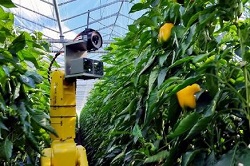Pepper robot harvester edges closer to commercialisation
Picking vegetables in greenhouses under humid and high temperature conditions can be a tough, uncomfortable and repetitive task – all factors behind the current decline in availability of farm workers to pick vegetables such as peppers. Today, many farmers are looking to overcome this problem and reduce their costs by automating labour. Technology – like robotic pepper harvesters - has been developed but it is still not market-ready. EU-funded project SWEEPER aims to bridge the gap between the laboratory and the market by ironing-out the problems in current prototype harvesters. The project then hopes to get harvesting robots for the greenhouse onto the market for the first time, helping to secure Europe’s role as a global leader in agricultural robotics. Overcoming challenges to reach the market ‘The reduction in the labour force has put major pressure on the competitiveness of the European greenhouse sector. We hope to develop the technology that will prevent greenhouse food production from migrating out of Europe due to the 40 % expected rise in labour costs over the coming decade,’ says SWEEPER project coordinator Jos Balendonck from Wageningen University in the Netherlands. So far, robotic harvesting systems have not been commercialised. Obstacles holding them back include the slow pace of current technology, which has a success rate of around 33 % and takes an average of 94 seconds to harvest one fruit or vegetable. Moreover, today’s robot harvesters are not robust enough, are difficult to control, and are not well enough integrated into post-harvest logistics. Building on past innovation SWEEPER itself builds on a previous EU-funded project, CROPS. CROPS researchers developed a prototype sweet pepper harvester and patented a gripper that can grip and cut peppers. The system can also do several different tasks including harvesting apples and grapes, and spraying. Over the 2016-2017 winter period, SWEEPER improved on CROPS’ pepper harvester technology by building in sensors and advancing algorithms to improve the localisation of fruit and the detection of fruit maturity. The robot can now detect obstacles and can calculate a collision-free path to the fruit, allowing maximum free space to grip and cut off the fruit. The project team also improved the software used to control the harvesting system and have made plans to automate post-harvest fruit and vegetable packing logistics. SWEEPER is now finalising a second prototype harvester which will be tested in the summer of 2017. Balendonck hopes that for the 2018 growing season, the system will be much improved, taking it closer to commercialisation. Meanwhile, SWEEPER is also considering factors like technology acceptance by growers. It has formed a European grower advisory board so that farmers can give feedback. The project has also studied the different types of greenhouse cultivation systems and has found that single row cultivation systems are best suited to automated picking since they boost fruit visibility and accessibility. SWEEPER is designed for peppers - a high-value European crop which has an estimated European yield of 1 900 000 000 kg per year. However, the technology can be easily modified and transferred to other crops. Meanwhile, Balendonck envisages making even more improvements, such as adding sensors that can detect vitamin content, levels of sweetness, expected shelf life of the fruit, and the ability to provide advanced crop disease warnings.
Keywords
SWEEPER, robotic harvesting systems, peppers, CROPS



